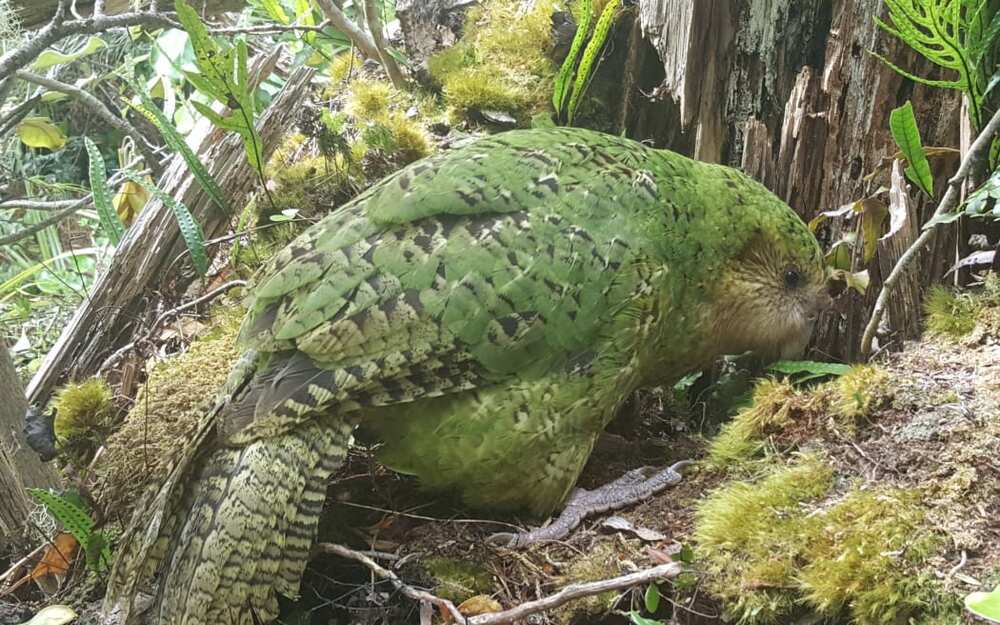What scientists just discovered about NZ’s critically-endangered kākāpō
RNZ
10 April 2023, 6:48 PM
 The kākāpō population now comprises only around 250 birds on three small, predator-free islands. Photo: Jake Osborne
The kākāpō population now comprises only around 250 birds on three small, predator-free islands. Photo: Jake OsborneScientists have used DNA tech and ancient kākāpō droppings to reveal what our critically-endangered flightless parrot was eating in Aotearoa's prehistoric wilderness.
Their newly published findings have roughly doubled the number of plants known to be eaten by kākāpō - and revealed many more striking insights that could aid efforts to bring the bird back from the brink.
Kākāpō - the rarest and heaviest parrot in the world - quickly disappeared from most of New Zealand after the introduction of predatory mammals.
Its population now comprises only about 250 birds on three small, predator-free islands.
They also heavily depend on the production of rimu fruit to breed, which only happens every two to five years.
This breeding cycle creates problems for kākāpō conservation, especially since rimu is not found across all New Zealand's forests.
However, fossils show that in the past, kākāpō were abundant and lived throughout Aotearoa - meaning the kākāpō niche must have been much broader in the past than today.
In a newly-published study, scientists from Manaaki Whenua Landcare Research and Auckland and Adelaide universities used cutting-edge ancient DNA techniques and microscopic techniques, to investigate what plants kākāpō were eating in ancient times.
They did this by looking at kākāpō coprolites - or preserved droppings - which have been found in caves across the South Island.
Radiocarbon dating also showed that these coprolites were typically hundreds of years old.
The new data has roughly doubled the number of plants known to be eaten by kākāpō and has revealed some striking revelations.
For example, in one site, almost half of the coprolites contained pollen of the wood rose, a species that is now highly endangered, entirely parasitic on other plants, has no leaves, and was thought to be pollinated only by threatened short-tailed bats.
Further evidence showed kākāpō were frequently eating southern beech and beech mistletoes, results new to this study.
The researchers questioned whether these plants may have supported kākāpō breeding, as did rimu today.
"Kākāpō are probably the only endangered species in the world that have such an extensive coprolite record," said study leader Dr Alexander Boast, a palaeoecologist at Manaaki Whenua.
"Since a lot of the food sources we identify aren't recorded in modern diets, we have learnt a lot of new information about kākāpō.
"However, more generally, we also show how modern data can hugely underestimate our understanding of endangered species."

Hoki, the first-ever hand-reared kākāpō, at her nest entrance under a rotten tree. Photo: RNZ / Alison Ballance
Colleague Dr Janet Wilmshurst said the study had come at a "critical time" for kākāpō conservation.
"The kākāpō population is increasing, and their islands can't sustain them for much longer," she said.
"Our work suggests that southern beech leaves and seeds were major kākāpō foods in the past, which is a big surprise since kākāpō hardly ever eat beech today.
"This means that beech forests are probably ideal habitats for kākāpō."
Co-author Dr Jamie Wood added: "The observation with mistletoes is especially interesting.
"Parasitic plants like mistletoes are more nutritious than other plants, meaning they could have been valuable sources of food for kākāpō and other birds in some habitats," said Wood, of the University of Adelaide.
"This is concerning because most New Zealand mistletoes are now in decline. We also show that kākāpō may be a lost pollinator for these threatened plants.
"Not just mistletoes, but also the parasitic wood rose, which we thought was only pollinated by bats."
The study also reflected some misconceptions about endangered species like kākāpō having a narrow habitat range.
"For example, there is a common misconception that kākāpō can't breed without rimu," said Professor George Perry, of the University of Auckland.
"However prehistoric evidence often shows that these species had much wider niches in the past.
"We should always use ancient data in conservation science when possible."

The explorers were right about European-introduced stoats, possums, cats, Norway and ship rats, being an important contributor to kākāpō decline since European arrival. Photo: Andrew Digby / DOC
Meanwhile, another new study authored by some of the same researchers has shed fresh light on what led up to the near-terminal decline of kākāpō.
Early European observers noted the bird population declining rapidly within their own lifetimes and speculated this was due to packs of feral European dogs and other mammal predators.
Using historical newspaper articles from the 19th and 20th centuries, and information from kākāpō museum specimens, the researchers were able to predict the species' likely local extinction dates.
These ranged from 1936 and 1959 in the North Island and between 1990 and 2006 in the South Island.
The researchers explain this time lag resulted from different prehistoric hunting and predation pressures, and extents of habitat transformation on the North and South Islands.
In the historic era, packs of feral dogs appeared to be a less important driver of kākāpō decline.
"Our analysis of more than 100 geo-referenced newspaper and scientific reports shows the distribution of kākāpō and feral dog packs did not overlap strongly anywhere, suggesting they did not frequently interact," said lead author Dr Jo Carpenter, of Manaaki-Whenua.
"Kākāpō also persisted in the South Island for up to 70 years after the last noted observation there of feral dogs in 1913."
Conversely, the explorers were right about the European-introduced stoats, possums, cats, Norway and ship rats, which have been a much more important contributor to kākāpō decline since European arrival.
"These animals would certainly have been the coup de grâce for this species if the birds hadn't been rescued from the wild," Wilmshurst said.



